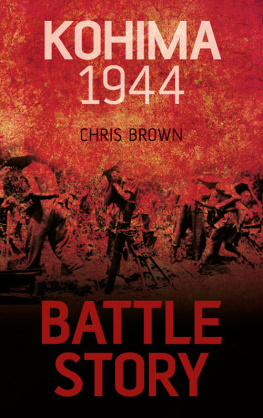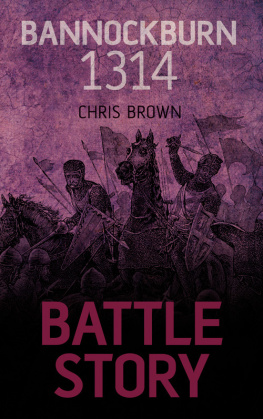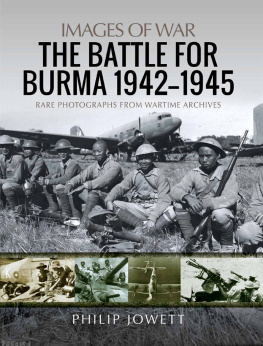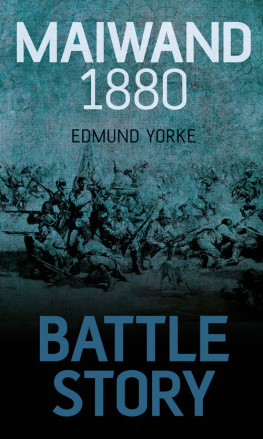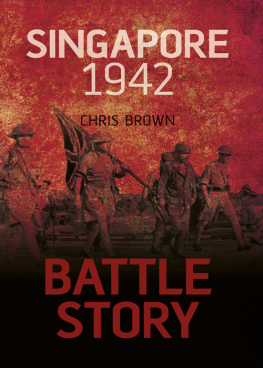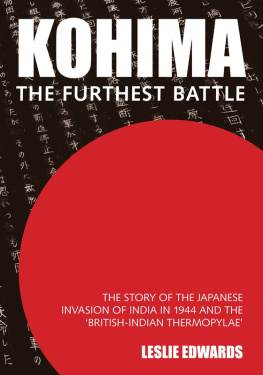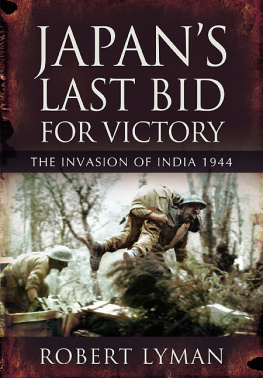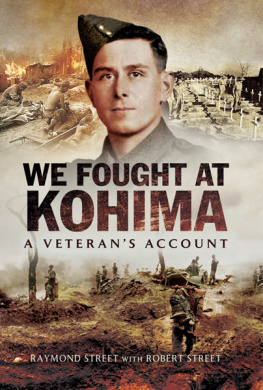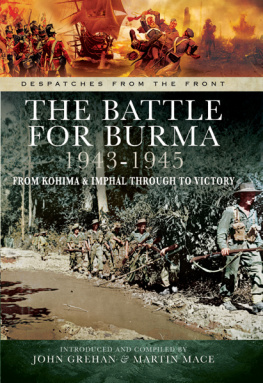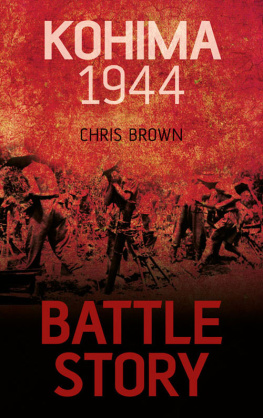
I am, as ever, indebted to my wife Pat and to my children for putting up with my interminable ramblings about this little book and every other book that I have written and to my editor at The History Press, Jo de Vries, for her advice and patience.
I am particularly grateful to the team at Dekko , the newsletter of the Burma Star Association, who kindly printed an appeal for help which brought me into touch with Mrs Rhona Palmer and Mrs Angela Benions. Mrs Palmer provided me with a copy of her fathers memoir of the war in Burma and has generously allowed me to include several photographs from his collection. Mrs Benions very kindly lent me a copy of her fathers recollections of the Burma theatre when I failed to find one myself.
I would also like to draw attention to the work of the Kohima Educational Trust. When the veterans of the battle held their last reunion in 2004, they decided to set up a trust to provide assistance with the education of Naga children in memory of the Commonwealth troops who fell in battle, and as an expression of gratitude for the sacrifice and loyalty of the Naga people in whose land the battle was fought. The trust does remarkable and valuable work, and is a cause worthy of support; it can be contacted at www.kohimaeducationaltrust.net.
This book is dedicated to three gentlemen gunners who served their country in the Second World War: my father, Peter Brown, who had the good fortune to arrive at the Burmese border at the best possible juncture of the campaign; to my late father-in-law, Robert Smith, who served in North Africa and Italy; and to John Laindon Cornwell, who was murdered by the Japanese Army on Ballali Island in 1943.
CONTENTS
Commonwealth Forces
The Imperial Japanese Army
Opening Manoeuvres
En Route to Kohima
The Noose Tightens
Surrounded
FSD Hill and Kuki Piquet
Relief
The Final Onslaught
1 A few of the 200,000 labourers who helped to construct and maintain roads through incredibly challenging country. (Courtesy of Mrs Angel Benions/A.W. Hickman, The Dawn Comes Up Like Thunder (AB/AWH))
2 Roads in Burma were prone to landslides and this often delayed the delivery of vital supplies. (AB/AWH)
3 Burmese landscape. Much of the campaign took place in mountainous terrain with fast-flowing rivers. (AB/AWH)
4 Kohima Ridge looking south from the air. (Authors collection)
5 A Grant tank loaded onto a raft for a river crossing. (AB/AWH)
6 General Stopford. (Authors collection)
7 Medium artillery. (AB/AWH)
8 Much of the field artillery had to be towed by jeeps due to the very difficult nature of the terrain. (AB/AWH)
9 Senior officers in a jeep passing troops at Mandalay. The jeep became a vital tool in the Burma campaign. (AB/AWH)
10 25-pounder guns; a workhorse of the Commonwealth artillery arm. (AB/AWH)
11 Commonwealth troops manning a light anti-tank gun. Although there was relatively little Japanese armour deployed to Burma, anti-tank weapons proved to be very useful against Japanese bunkers. (AB/AWH)
12 General Slim. (Authors collection)
13 Gurkhas advancing with tanks to clear the Japanese from the Imphal-Kohima Road in North Eastern British India. (Authors collection)
14 Japanese anti-tank rifle. Virtually ineffective against the later models of Commonwealth tanks, the anti-tank rifle was still a potent weapon against Bren Carriers and armoured cars. (Authors collection)
15 Japanese flag. (Authors collection)
16 A typical Japanese soldier. (Authors collection)
17 Riflemen with the Arisaka rifle. (Authors collection)
18 A speeding Ha-Go Type 95 tank. (Authors collection)
19 The Japanese knee mortar grenade launcher. (Authors collection)
20 A convoy approaching Kohima. (AB/AWH)
21 A convoy on the Kohima Road. (AB/AWH)
22 A landslide blocking the road a common event in Burma. (AB/AWH)
23 Crossing the Irrawaddy River. (AB/AWH)
24 Loading a pack howitzer onto a raft for a river crossing. (AB/AWH)
25 Commonwealth troops in action in the Arakan. (AB/AWH)
26 American supply trucks on the Burma Road. (AB/AWH)
27 A captured Japanese artillery piece. (AB/AWH)
28 A dug-out at Kohima. (AB/AWH)
29 Defoliation from shelling at Kohima. (AB/AWH)
30 Extensive air supply operations occurred throughout Burma. (AB/AWH)
31 Shattered houses on the Kohima battlefield. (AB/AWH)
32 Commonwealth troops on the march. (AB/AWH)
33 Commonwealth troops manning a light anti-tank gun. (AB/AWH)
34 Airstrike on a Japanese supply train. (AB/AWH)
35 A Fourteenth Army observation post directing artillery fire. (AB/AWH)
36 British troops at Kohima. (Authors collection)
37 A view of the shell-scarred Kohima battlefield. (AB/AWH)
38 Battle-damaged building at Kohima. (AB/AWH)
39 Chinese and American drivers on the Burma Road. (AB/AWH)
40 Battlefield defoliation. (AB/AWH)
41 Devastated buildings immediately after the battle. (AB/AWH)
42 Japanese prisoners of war. Very few Japanese soldiers surrendered until the later stages of the campaign in 1945. (AB/AWH)
43 The Kohima Memorial. (AB/AWH)
Maps
Map 1 | Commonwealth lines of communication in the Arakan. (Butler, James, The War Against Japan , p.5) |
Map 2 | The Japanese Ha-Go Offensive, February 1944. A diversionary operation designed to force Slim to commit forces in the Arakan, well away from the targets of the main offensive against Imphal. (Butler, p.140) |
Map 3 | The Kohima area. (Butler, p.360) |
Map 4 | The actions proceeding Kohima at Ukhrul, Sheldons Corner and Sangshak. (Butler, p.248) |
Map 5 | Kohima Ridge. (Butler, p.347) |
Map 6 | The Commonwealth counter-offensive from Imphal. (Butler, p.352) |
Operation U-Go: the Road to Kohima
The battle, or more accurately, the siege and relief of the Burmese hill town of Kohima is a tale of incredible endurance and collective courage. Although usually associated with one British rifle battalion 4th Royal West Kents (RWK) elements of many other regiments, corps and departments were involved; in fact, the majority of the combat soldiers in the garrison comprised Ghurkha, Indian, Nepalese and Burmese soldiers whose service has been rather forgotten.
Although the Japanese attack would eventually fail, it is all too easy to overlook the incredible feat of soldiering involved in bringing a whole division with artillery, engineering and medical assets through many miles of crude tracks, steep mountains, thick forests and dense jungle of western Burma and north-east India. The 31st Division of the Imperial Japanese Army made the march from the Chindwin to Kohima with virtually no motor transport, so General (Gen.) Kotoku Satos plans largely depended on what his men could carry on their backs, plus trains of mules, ponies, horses and elephants. His force also had no air support, a very limited capacity for dealing with casualties and very poor lines of communication. Despite the assurances of his superior, Gen. Renya Mutaguchi, it proved impossible to achieve a reliable line of supply and, although his force attempted to drive large herds of cattle to provide beef on the hoof, his men were soon challenged by hunger, the terrain and an increasingly competent and confident Commonwealth army.
Next page
